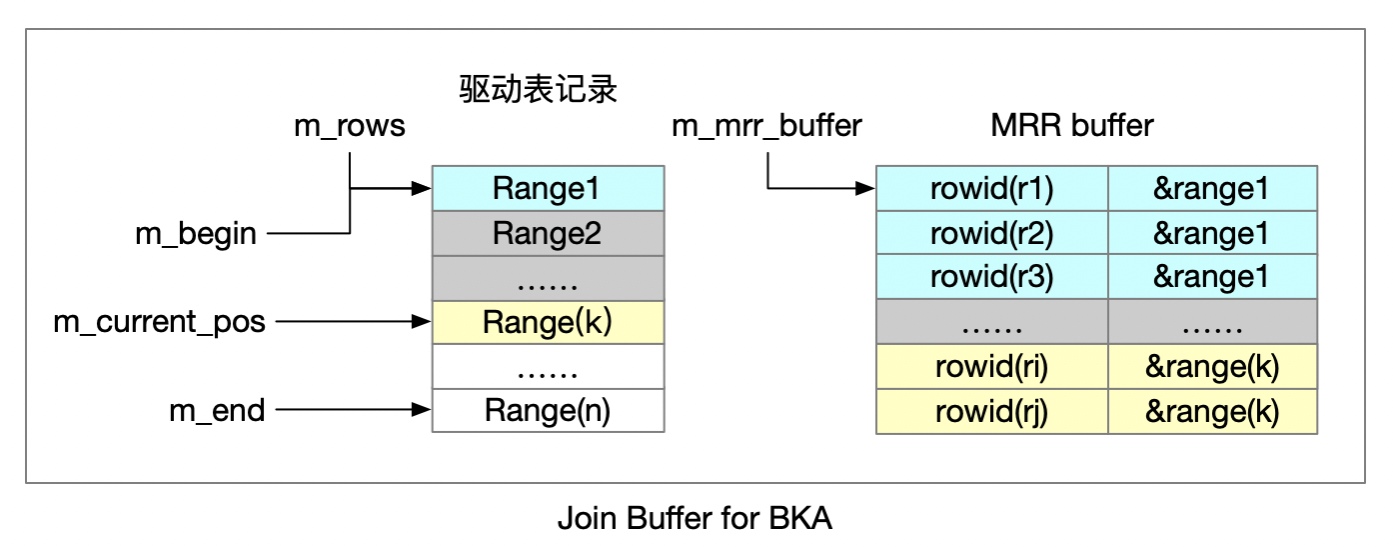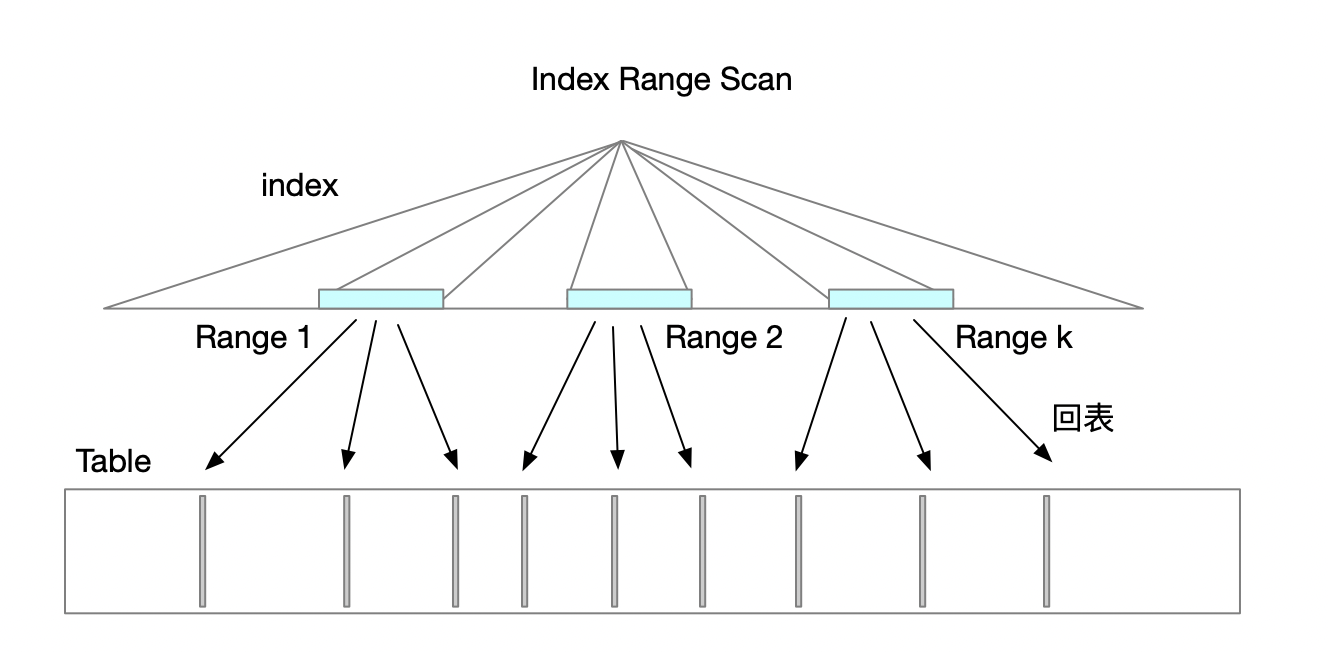MySQL优化器特性(六)表扫描成本计算
全表扫描成本
使用optimizer_trace,或者使用explain format=tree, 或者explain format=json,可以查看查询的cost
mysql> explain format=tree select * from test_ror; +---------------------------------------------------+ | EXPLAIN | +---------------------------------------------------+ | -> Table scan on test_ror (cost=10.75 rows=105) | +---------------------------------------------------+ 1 row in set (0.00 sec)
mysql> explain format=json select * from test_ror;
{
"query_block": {
"select_id": 1,
"cost_info": {
"query_cost": "10.75"
},
"table": {
"table_name": "test_ror",
"access_type": "ALL",
"rows_examined_per_scan": 105,
"rows_produced_per_join": 105,
"filtered": "100.00",
"cost_info": {
"read_cost": "0.25",
"eval_cost": "10.50",
"prefix_cost": "10.75",
"data_read_per_join": "2K"
},
"used_columns": [
"id",
"a",
"b",
"c"
]
}
}
}从上面的例子可以看到,查询总cost为10.75,其中包括read_cost 0.25, eval_cost 10.50。
我们来分析下这里的成本分别是怎么计算的。
全表扫描成本
全表扫描成本计算代码位于sql/sql_planner.cc文件,函数Optimize_table_order::best_access_path中计算。
double scan_read_cost = calculate_scan_cost( tab, idx, best_ref, prefix_rowcount, found_condition, disable_jbuf, &rows_after_filtering, &trace_access_scan); /* We estimate the cost of evaluating WHERE clause for found records as row_evaluate_cost(prefix_rowcount * rows_after_filtering). This cost plus scan_cost gives us total cost of using TABLE/INDEX/RANGE SCAN. */ const double scan_total_cost = scan_read_cost + cost_model->row_evaluate_cost(prefix_rowcount * rows_after_filtering);
成本分为两部分:
扫描表的IO成本(table_scan_cost)
读取记录、分析记录的成本(row_evaluate_cost)
需要注意,这里的全表扫描成本,是在没有其他访问路径可选的情况下计算得到的成本。优化器在评估索引范围扫描的成本时,也会先评估一下全表扫描的成本,这时计算全表扫描的成本公式和本文的描述会有一些差异。
table_scan_cost
Cost_estimate handler::table_scan_cost() {
/*
This function returns a Cost_estimate object. The function should be
implemented in a way that allows the compiler to use "return value
optimization" to avoid creating the temporary object for the return value
and use of the copy constructor.
*/
const double io_cost = scan_time() * table->cost_model()->page_read_cost(1.0);
Cost_estimate cost;
cost.add_io(io_cost);
return cost;
}scan_time
对于innodb引擎,scan_time取primary key(cluster index)的大小(单位是page)。
double ha_innobase::scan_time() {
ulint stat_clustered_index_size;
stat_clustered_index_size = m_prebuilt->table->stat_clustered_index_size;
return ((double)stat_clustered_index_size);
}这个信息最终从统计信息中获取:
mysql> select * from mysql.innodb_table_stats where database_name='test' and table_name='test_ror'; +---------------+------------+---------------------+--------+----------------------+--------------------------+ | database_name | table_name | last_update | n_rows | clustered_index_size | sum_of_other_index_sizes | +---------------+------------+---------------------+--------+----------------------+--------------------------+ | test | test_ror | 2023-05-06 15:07:16 | 105 | 1 | 3 | +---------------+------------+---------------------+--------+----------------------+--------------------------+
page_read_cost
page_read_cost会基于表在内存中的缓存比例来计算读取数据块的成本。mysql会评估表的缓存比例,分别计算内存中的块的数量以及磁盘中的块的数据量,
pages_in_mem = pages * in_mem
pages_on_disk = pages - pages_in_mem
cost = pages_in_mem * memory_block_read_cost + pages_on_disk * io_block_read_cost
其中memory_block_read_cost和io_block_read_cost分别代表从内存和磁盘上读取一个页面的成本,这两个值可以在mysql.engine_cost中配置。8.0版本中,memory_block_read_cost默认为0.25,io_block_read_cost默认为1。
page_read_cost代码:
double Cost_model_table::page_read_cost(double pages) const {
assert(m_initialized);
assert(pages >= 0.0);
// 表cache在内存中的比例,范围是0 - 1,0表示所有数据都不在内存中。1表示所有数据都缓存在内存中
const double in_mem = m_table->file->table_in_memory_estimate();
const double pages_in_mem = pages * in_mem;
const double pages_on_disk = pages - pages_in_mem;
assert(pages_on_disk >= 0.0);
// buffer_blaock_read_cost:从内存中读取page的成本
// io_block_read_cost:从磁盘上读取page的成本
const double cost =
buffer_block_read_cost(pages_in_mem) + io_block_read_cost(pages_on_disk);
return cost;
}table_in_memory_estimate:计算表和索引数据缓存率
对于InnoDB,MySQL会维护每个索引缓存在内存中的Page数,可以基于这个数据计算出数据的缓存率。如果存储引擎没用提供缓存率数据(如MyISAM存储引擎),mysql会使用一个经验公式来预估数据的缓存率,具体逻辑在函数estimate_in_memory_buffer中实现。
double handler::table_in_memory_estimate() const {
assert(stats.table_in_mem_estimate == IN_MEMORY_ESTIMATE_UNKNOWN ||
(stats.table_in_mem_estimate >= 0.0 &&
stats.table_in_mem_estimate <= 1.0));
/*
If the storage engine has supplied information about how much of the
table that is currently in a memory buffer, then use this estimate.
*/
if (stats.table_in_mem_estimate != IN_MEMORY_ESTIMATE_UNKNOWN)
return stats.table_in_mem_estimate;
/*
The storage engine has not provided any information about how much of
this index is in memory, use an heuristic to produce an estimate.
*/
return estimate_in_memory_buffer(stats.data_file_length);
}estimate_in_memory_buffer
根据表的大小和内存大小计算表的缓存率。对于InnoDB,内存大小是指InnoDB Buffer Pool的大小。
经验公式:如果表占用的空间不到内存的20%,则认为所有数据都缓存在内存中(缓存率为1)。如果表占用的空间超过内存的大小,则认为缓存率为0。介于两者之间的表,缓存率为 ( 1 - x ) / 0.8, 0.2 < x < 1,x为表的大小和内存大小的比值。
double handler::estimate_in_memory_buffer(ulonglong table_index_size) const {
/*
The storage engine has not provided any information about how much of
the table/index is in memory. In this case we use a heuristic:
- if the size of the table/index is less than 20 percent (pick any
number) of the memory buffer, then the entire table/index is likely in
memory.
- if the size of the table/index is larger than the memory buffer, then
assume nothing of the table/index is in memory.
- if the size of the table/index is larger than 20 percent but less than
the memory buffer size, then use a linear function of the table/index
size that goes from 1.0 to 0.0.
*/
longlong memory_buf_size = get_memory_buffer_size();
if (memory_buf_size <= 0) memory_buf_size = 100 * 1024 * 1024; // 100 MB
const double table_index_in_memory_limit = 0.2;
const double percent_of_mem =
static_cast<double>(table_index_size) / memory_buf_size;
double in_mem_est;
if (percent_of_mem < table_index_in_memory_limit) // Less than 20 percent
in_mem_est = 1.0;
else if (percent_of_mem > 1.0) // Larger than buffer
in_mem_est = 0.0;
else {
in_mem_est = 1.0 - (percent_of_mem - table_index_in_memory_limit) /
(1.0 - table_index_in_memory_limit);
}
return in_mem_est;
}InnoDB表和索引缓存率的计算
InnoDB维护了每个索引在buffer pool中缓存的页面数,基于这个统计数据,可以计算InnoDB索引的缓存率。
InnoDB表的缓存率为主键的缓存率。(如果InnoDB没有建立显式主键,则好像不会记录表的缓存率,这种情况下会使用经验公式来预估缓存率)。
变量buf_stat_per_index记录了每个索引缓存在buffer pool中的页面数。
/** Estimate what percentage of an index's pages are cached in the buffer pool
@param[in] index index whose pages to look up
@return a real number in [0.0, 1.0] designating the percentage of cached pages
*/
inline double index_pct_cached(const dict_index_t *index) {
const ulint n_leaf = index->stat_n_leaf_pages;
if (n_leaf == 0) {
return (0.0);
}
const uint64_t n_in_mem =
buf_stat_per_index->get(index_id_t(index->space, index->id));
const double ratio = static_cast<double>(n_in_mem) / n_leaf;
return (std::max(std::min(ratio, 1.0), 0.0));
}row_evaluate_cost
row_evaluate_cost计算访问行的成本,计算公式为 rows * row_evaluate_cost,row_evaluate_cost的值可以在mysql.server_cost表配置,8.0版本中,这个值默认为0.1,也就是访问一行数据的成本是0.1。
double row_evaluate_cost(double rows) const {
return rows * m_server_cost_constants->row_evaluate_cost();
}回到本文开始的例子,这个表总共有105行记录,cluster index占用了1个页面,数据全部缓存在内存中,总体成本计算:
io_cost = cluster_index_size * 0.25
row_eval_cost = rows * 0.1 = 10.5
cost = io_cost + row_eval_cost = 0.25 + 10.5 = 10.75



